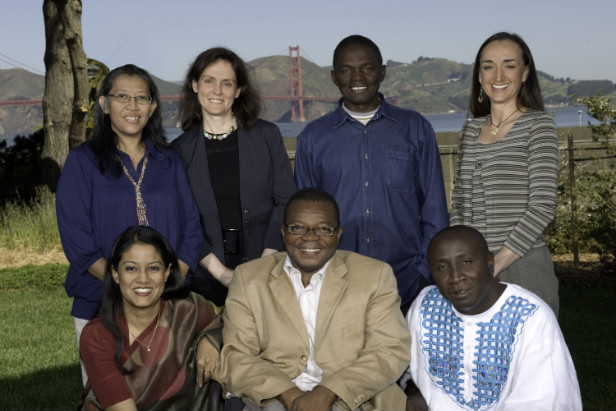 The 2009 winners of the Goldman Environmental Prize. Standing, L-R: Yuyun Ismawati, Olga Speranskaya, Wanze Eduards, and Maria Gunnoe. Front row, L-R: Rizwana Hasan, Marc Ona Essangui, and Hugo Jabini
The 2009 winners of the Goldman Environmental Prize. Standing, L-R: Yuyun Ismawati, Olga Speranskaya, Wanze Eduards, and Maria Gunnoe. Front row, L-R: Rizwana Hasan, Marc Ona Essangui, and Hugo Jabini
By rights it should be a daunting moment. Every fall a courier turns up at my door with a package containing a thick, densely typed dossier. I know, as I take the delivery, that days of solid reading and hard decisions lie ahead.
And yet receiving the package never fails to lift my spirits. Whatever I am doing, I stop, tear it open, and leaf rapidly through its pages. For I know that it is going to introduce me to some of the finest and bravest people on Earth.
The dossier contains detailed briefs on the finalists for the Goldman Environmental Prize — the world’s largest award for grassroots environmental activists, which this week celebrated its 20th anniversary in the San Francisco Opera House. The package comes to my door because I have the luck to be one of the jury members who each November gets to select the six winners, one from each of the six inhabited continents (Australia is grouped with other islands and island nations).
Most environmental prizes go to worthy but well-known figures, most of whose mantelpieces already groan under the burden of similar honors. The Goldman Prize, by contrast, is for the unknowns and unrecognized, individuals who are fighting — and winning — desperate battles, often in obscure corners of the planet, almost always against overwhelming odds, and commonly at immense personal risk.
Flicking through the dossier for that first, fascinated, time, I find that almost all of the finalists are new to me, despite four decades as a reporter on the international environmental beat. As I get down to studying their stories, my breath is taken away by their courage. Death threats go with the territory. Some have survived actual assassination attempts; others have been imprisoned, even tortured. Most have been persecuted in some way. Yet they have persisted, and won.
Example after example springs to mind. There’s Anna Giordano, a young woman who took on the Mafia, drastically reducing the number of wild birds shot in Sicily and narrowly escaping the firebombing of her car. Alexander Nitikin was imprisoned for revealing the risks posed by Russia’s decaying nuclear submarines; Rodolfo Montiel Flores was jailed and tortured for opposing logging that was drying up water supplies for his Mexican village (his lawyer was assassinated); Yosepha Alomang, an elderly woman, was tortured for six weeks for fighting destructive mining in Irian Jaya.
Then there’s Julia Bonds, a former Pizza Hut waitress who — despite frequent death threats — successfully fought the mountaintop-removal mining that has flattened some 470 peaks in the Appalachians. Next up are Rashida Bee and Champa Devi Shukla — frail, diminutive, and illiterate women who went on hunger strike to get justice for victims of the Bhopal disaster.
And a fellow juror, the Nobel Peace Laureate Wangari Maathai, has credited winning the Goldman Prize with helping to save her life when she was under intense attack as a relatively unknown Kenyan environment and democracy campaigner 18 years ago. The prize, she says, recognizes “people like me … when nobody else could see them.”
Over the last 20 years, some 126 such heroes from 76 countries have received the prize, providing them with a sum of money (currently $150,000) big enough transform their campaigns, and international recognition that can both greatly boost their cause and give them some protection.
The prize was founded by Richard Goldman and his late wife Rhoda in 1989. He recounts how at breakfast one day, reading about the Nobel Prizes in his newspaper, he “wondered if there was a comparable award for environmental work.” Research failed to reveal one, and crucially the Goldmans decided to concentrate on recognizing grassroots work.
Now 50 green organizations and 150 environmental experts from more than 70 countries nominate candidates, who are meticulously researched over a five-month period by the Goldman Prize’s small, but dedicated, staff.
Nine of us meet to make the decision; Richard Goldman and his three surviving children — John, Douglas, and Susan — and five others like me from the other continents. Though very different from each other, we reach agreement quickly, after tough but remarkably good humoured debates, because the preparatory work is so good.
This year’s winners are as remarkable as ever:
- Wheelchair-bound Marc Ona survived imprisonment to win a victory over a destructive mining project in Gabon.
- Maria Gunnoe, a coal miner’s daughter, successfully continues Julia Bond’s fight against mountaintop removal, despite danger to herself and her children.
- Olga Speranskaya is cleaning up toxic chemicals in Russia and Eastern Europe.
- Yuyun Ismawati has pioneered community solutions for municipal waste in Indonesia.
- Rizwana Hasan has halted hazardous and environmentally devastating ship-breaking in Bangladesh.
- And a fearless fight by Wanze Eduards and Hugo Jabini against logging in Suriname has led to a landmark legal ruling that will give indigenous people throughout the Americas rights to control exploitation of their lands.
As for me, I can’t wait for next year’s dossier to arrive seven months from now so that I can learn about another load of people just like them.



